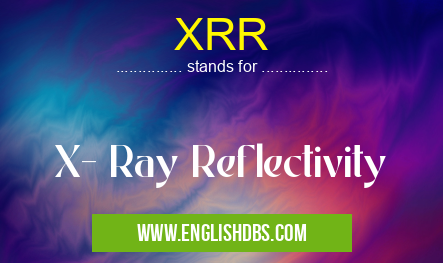What does XRR mean in CHEMISTRY
X-Ray Reflectivity (XRR) is a surface-sensitive technique used to determine the thickness and composition of thin films and interfaces between materials. The incident X-ray beam reflects off the surface of the system, producing an interference pattern that can be analysed to reveal information about the structure, number of layers and layer thickness present. XRR is widely applied in many areas such as semiconductor device fabrication and optical coatings. It is a powerful tool for characterizing surfaces with nanometer precision.

XRR meaning in Chemistry in Academic & Science
XRR mostly used in an acronym Chemistry in Category Academic & Science that means X- Ray Reflectivity
Shorthand: XRR,
Full Form: X- Ray Reflectivity
For more information of "X- Ray Reflectivity", see the section below.
What Is XRR?
XRR is a nondestructive analytical method which measures the intensity of X-rays reflecting off a material's interface or surface, as well as its nearby layers. By analysing this reflected signal, information on surface roughness, layer thicknesses and chemical composition can be derived. The beam energy used in XRR experiments can range from near-infrared all the way up to hard X-rays, enabling samples that are not visible optically to be studied.
How Does it Work?
The process works by shining an intense X-ray beam onto a sample at an ideal angle so that some of the radiation bounces back toward a detector. This detector captures how much radiation is being reflected at each angle as well as any changes in intensity due to interference effects caused by different layers within the sample's structure. This allows other properties like density and roughness to be calculated from this data.
Essential Questions and Answers on X- Ray Reflectivity in "SCIENCE»CHEMISTRY"
What is X-Ray Reflectivity?
X-Ray Reflectivity (XRR) is a tool used for analyzing nanoscale thin film structures. It uses a X-ray beam to measure the reflectivity of a sample, which is then compared with theoretical models of the structure to determine its thickness, composition and any other characteristics.
How does X-Ray Reflectivity work?
In XRR, an intense beam of X-rays is directed at the sample surface. The reflected beam is then measured by detectors, which can be analyzed to determine the structure and properties of the sample.
What types of materials are suitable for X-Ray Reflectivity?
XRR is suitable for samples with sharp interfaces between two different materials, such as metal/dielectric bilayers or thin films on substrates. These materials can range from organic polymers to metals and semiconductors.
What kind of information can I get from performing an XRR analysis?
By performing an XRR analysis you can gain information regarding the thickness, composition and interface roughness of your sample. It also provides information regarding relaxation effects in thin films or multilayer stacks.
What are the advantages of using XRR over other characterization techniques?
The main advantage of using XRR over other techniques is its non-destructive nature; it enables measurements to be made on delicate samples without risk of damage or contamination. Additionally, it can provide details down to a few nanometers in size and measure even abrupt changes in interface structure or composition.
What kind of laboratory equipment is necessary for performing an XRR analysis?
Generally speaking, one would need a source that emits a monochromatic x-ray beam (such as an x-ray tube), mirrors for collimating the beam, precise positioning stages for directing the beams onto the sample surfaces, detectors for measuring the reflected x-ray intensity from each surface and software for data acquisition and analysis.
How accurate are measurements taken using an XRR system?
Accuracy depends on several factors such as incident angle accuracy and detector resolution, but generally resolutions up to 0.1 nm can be achieved depending on requirements.
How long does it take to perform an XRR measurement?
A typical measurement will usually take anywhere between 10 minutes and several hours depending on how many layers need to be analysed and how much data needs collected.
Are there any applications where one should not use XRR?
While it's possible to use this technique in most situations involving thin films or multilayer stacks, it might not be ideal when measuring nonuniformity over large areas since it requires single point exposures only due to its low sampling speed compared with other characterization methods like scanning electron microscopy (SEM).
Final Words:
Overall, XRR plays an integral role in understanding structures on surfaces or within interfaces on both small and large scales, for a diverse range of materials including polymers, metals, semiconductors and organic molecules. Its use extends across numerous industries such as electronics manufacturing where it is used for quality control purposes prior to production; therefore ensuring that devices are made with accurate specifications every time.
